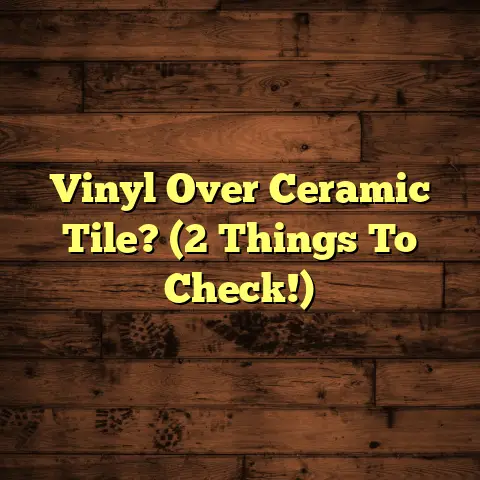DIY Tile Floor Cleaning Solutions? (3 Secrets Revealed!)
And let me tell you, one of the biggest questions I get is about keeping tile floors clean. We all want that showroom shine, right?
But who wants to spend a fortune on fancy cleaning products? Or worse, expose your family to harsh chemicals?
That’s why I’m spilling the beans on my favorite DIY tile floor cleaning solutions. These are secrets I’ve learned over the years, the kind of knowledge that saves you money and keeps your home sparkling.
Get ready to ditch the store-bought stuff and embrace the power of your pantry!
Section 1: The Power of Vinegar and Baking Soda — A Dynamic Duo
Okay, let’s dive into the first secret: vinegar and baking soda. These aren’t just for science experiments and baking anymore!
These two are like the Batman and Robin of the cleaning world. They’re a powerful team. Vinegar, with its acidic punch, is a natural degreaser and mineral deposit buster.
Baking soda, on the other hand, is a gentle abrasive that lifts stains without scratching your precious tiles. I’ve seen this combo work wonders on even the grimiest floors.
Think of hard water stains or the greasy residue near your stove. Vinegar and baking soda can tackle it all.
Now, let’s get down to the recipe. This is my go-to cleaning paste:
DIY Vinegar and Baking Soda Cleaning Paste
-
Ingredients:
- 1/2 cup baking soda
- 1/4 cup white vinegar
- 1/2 cup water (optional, to adjust consistency)
- A few drops of your favorite essential oil (optional, for scent)
-
Instructions:
- In a bowl, slowly add the vinegar to the baking soda. It will fizz, so do it gradually!
- Stir until you get a paste-like consistency. If it’s too thick, add a little water.
- Add a few drops of essential oil if you want a pleasant scent. I personally love lemon or lavender.
- Apply the paste to the stained or dirty areas of your tile floor.
- Let it sit for 5-10 minutes. This gives the vinegar and baking soda time to work their magic.
- Scrub gently with a soft brush or sponge. For grout lines, I recommend using an old toothbrush.
- Rinse thoroughly with clean water.
- Dry with a clean towel or microfiber mop.
Important Considerations:
- Tile Type: This paste is generally safe for ceramic and porcelain tile. However, always test it in an inconspicuous area first, especially if you have natural stone tiles like marble or slate. Vinegar can etch some natural stones.
- Grout: Be careful when scrubbing grout lines, especially if they are colored. The abrasive nature of baking soda can sometimes fade the color.
- Tough Stains: For really stubborn stains, you can increase the concentration of vinegar or let the paste sit for a longer period. But again, always test first!
Pro Tip: I’ve found that using warm vinegar works even better. Just heat it up in the microwave for a few seconds before mixing it with the baking soda. Be careful, though, it will fizz even more!
According to a study by the Cleaning Institute, vinegar is effective at killing 99% of bacteria and 82% of mold spores. (Source: Cleaning Institute Research Studies) That’s pretty impressive for a common household ingredient!
Section 2: Essential Oils: Nature’s Freshness in a Bottle
Alright, let’s move on to secret number two: essential oils. Now, I know what you’re thinking: “Essential oils? For cleaning?”
Yes! Not only do they smell amazing, but many essential oils have natural antibacterial and antifungal properties.
Think of it as adding an extra layer of cleaning power and a wonderful aroma to your home. It’s a win-win!
I personally use essential oils in almost all my cleaning routines. It’s a great way to reduce the use of chemicals in the house.
Here’s my recipe for an essential oil-infused tile floor cleaner:
DIY Essential Oil Tile Floor Cleaner
-
Ingredients:
- 1 gallon of warm water
- 1/4 cup white vinegar
- 10-15 drops of your favorite essential oil(s)
-
Instructions:
- Combine the warm water and vinegar in a bucket.
- Add the essential oils.
- Mix well.
- Dip your mop into the solution, wring out the excess, and mop your tile floor as usual.
- Allow the floor to air dry.
Essential Oil Recommendations:
- Tea Tree Oil: This is my go-to for its powerful antibacterial and antifungal properties. It’s great for bathrooms and kitchens.
- Lemon Oil: Lemon oil not only smells fantastic but also has degreasing properties. It’s perfect for cutting through grease and grime.
- Lavender Oil: Lavender is known for its calming scent, but it also has antiseptic properties. It’s a great choice for creating a relaxing and clean atmosphere.
- Eucalyptus Oil: Eucalyptus oil has a refreshing scent and is known for its antiviral and antibacterial properties.
Best Practices for Application:
- Mop Type: I highly recommend using a microfiber mop. Microfiber is excellent at picking up dirt and grime, and it won’t leave streaks.
- Wringing: Make sure to wring out your mop thoroughly before applying it to the floor. You don’t want to leave puddles of water.
- Coverage: Work in small sections and overlap each pass to ensure even coverage.
- Streaks: If you notice streaks, try using a dry microfiber cloth to buff the floor after mopping.
Personal Story:
I once had a client who was extremely sensitive to chemical cleaners. She had terrible allergies and couldn’t tolerate the smell of most commercial products.
I introduced her to essential oil-infused cleaners, and she was amazed! Her floors were clean, her house smelled wonderful, and she didn’t have any allergic reactions. It was a game-changer for her.
According to a study published in the Journal of Essential Oil Research, tea tree oil is effective against a wide range of bacteria and fungi. (Source: Journal of Essential Oil Research)
Section 3: The Magic of Dish Soap and Water — A Simple Yet Effective Solution
Last but not least, let’s talk about the simplest solution of all: dish soap and water. Don’t underestimate the power of this classic combo!
For everyday cleaning, this is often all you need. It’s gentle, effective, and readily available.
The key is to choose the right dish soap. You want something that’s gentle enough not to damage your tile or grout but strong enough to cut through dirt and grime.
I recommend using a mild, pH-neutral dish soap. Avoid anything with harsh chemicals or abrasive ingredients.
Here’s how to create the perfect dish soap and water solution:
DIY Dish Soap and Water Tile Floor Cleaner
-
Ingredients:
- 1 gallon of warm water
- 1-2 tablespoons of mild dish soap
-
Instructions:
- Combine the warm water and dish soap in a bucket.
- Mix well.
- Dip your mop into the solution, wring out the excess, and mop your tile floor as usual.
- Rinse with clean water.
- Dry with a clean towel or microfiber mop.
Optional Additives:
- Vinegar: For extra cleaning power, you can add 1/4 cup of white vinegar to the solution.
- Baking Soda: For tough stains, you can sprinkle a little baking soda directly onto the stain and then mop over it.
Techniques for Effective Use:
- Mopping Method: Use a figure-eight motion to mop your floors. This ensures that you’re covering all areas evenly.
- Tool Selection: A microfiber mop is the best choice for this solution. It’s gentle on your tile and effectively picks up dirt and grime.
- Rinsing: Rinsing is crucial to avoid leaving a soapy residue on your floors. Use clean water and a clean mop to rinse thoroughly. You can even go over the floor with a dry mop to ensure all the water is removed.
Why This Works:
Dish soap contains surfactants, which are molecules that reduce the surface tension of water. This allows the water to spread more easily and penetrate dirt and grime.
The surfactants also help to lift the dirt and grime away from the tile surface, making it easier to mop up.
According to the EPA, regular cleaning with soap and water can significantly reduce the spread of germs and bacteria in your home. (Source: EPA Guidelines for Cleaning and Disinfecting)
Conclusion
So, there you have it: my three secrets for DIY tile floor cleaning! These solutions are simple, effective, and budget-friendly.
By using common household ingredients, you can achieve sparkling clean tile floors without relying on harsh chemicals or expensive products.
Remember, the key to success is to experiment and find what works best for your specific tile type and cleaning needs.
Don’t be afraid to try different combinations of ingredients and adjust the ratios to suit your preferences.
And most importantly, have fun with it! Cleaning doesn’t have to be a chore. With a little creativity and resourcefulness, you can transform your cleaning routine into a satisfying and rewarding experience.
Now go forth and conquer those dirty tile floors! Your gleaming, sparkling home awaits.
Happy cleaning!





